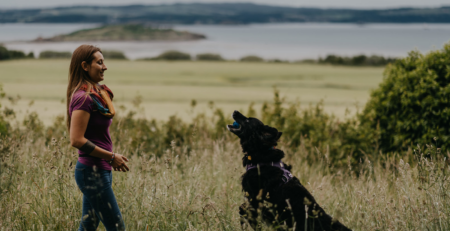Setting up tech for separation training
admin2023-03-08T10:38:34+00:00In order to change how your dog behaves when home alone, we need to make sure we change how they FEEL about being left. We do this by always training “below threshold”, meaning before they get worried.
We know we’re training at the right level for your dog by looking for behavioural clues, for example:
- How does your dog respond as you stand up and start to leave the room
- What do they do when they see/ hear you locking, unlocking and exiting your door
- What behaviours does your dog engage in whilst you are gone?
- The presence of small, subtle behaviours such as lip licks, yawns, freezing or shake offs.
With so many great tech developments in recent years, you don’t have to guess how your dog is feeling during absence training, you can watch them in real time and make recordings to review for smaller details later on.
We therefore require all separation training clients to get comfortable using cameras to observe their dogs’ behaviour. By feeding back your observations, we can then coach you on your separation training journey and help move things forward by designing each separation exercise based on how well your dog did with the last.
TOP TIP: There are various options for observing your dog, and the great news is most are inexpensive. Some require no additional investment at all, however our top tip is to buy a purpose built pet cam (or two!) as this will make your training, and all future absences easier for you and your dog. Having a pet cam ready to go, means set up time for absences is less, takes the guesswork out of how your dog is doing, gives you peace of mind, and allows you to check back and find out what happened if things don’t go to plan.
Best cameras for dog separation training with us
There are many different cameras on the market nowadays, ranging from less than £20 to over £100 per camera. There is no need to get the most expensive camera, but getting a good quality camera which is easy to use is well worth the investment!
Things to take into consideration:
- Does the camera record? When absence training with your dog (or leaving them home alone for real), it is important to watch your camera live as well as recording your video. Watching live allows you to see if your dog is reaching their threshold (starting to feel worried/panicked), giving you an opportunity to come back in and avoid a negative/ panicked experience. Being able to review records allows you to review finer details, or things that you might miss when watching live. We offer video review as part of our separation training packages, so being able to record and edit short clips means you can get the most out of our expertise too.
- Does the company require a subscription in order to record videos? Some cameras need you to sign up to a monthly payment plan to record videos as they need you to store videos on their cloud. We would recommend going for a camera with a memory card instead to cut long term costs.
- Is the camera fixed, or does it rotate remotely? Cameras with 360 degrees vision can be really helpful if your dog moves around during the absence, and can potentially reduce the number of cameras needed in each room.
- Is the picture clear? You are going to be watching your dog really closely for subtle indicators that they are feeling uneasy or worried about you leaving. This could be a bit of tension in their face, their ears moving backwards, a flick of their tongue or a yawn etc. It is really helpful if your camera has a clear picture so you can spot these subtle behaviours.
- Plug in, or wireless? The benefit of a wireless camera is it gives you more choice for camera placement. However, this does come with some downsides. You will need to remember to charge your camera. Battery life and signal strength are additional considerations, especially when you get to longer absence durations – you don’t want the camera cutting out when you’re 15 mins from home!
- How many cameras do I need? Ideally, we advise having enough cameras to cover the main areas your dog is likely to go when you leave. We advise covering the main place your dog would rest if relaxed, and the areas they would go to if stressed (e.g. the front door or a window). If you’re not sure, the most cost effective options is usually two cameras, and we’d recommend this option if you plan to give your dog access to more than one room.
- Is there an alternative to splashing out on a pet cam? If you have not yet got a camera, you can always use multiple devices e.g. phone and laptop and video call yourself to get eyes on your dog that way. If you go for this option, think about how you can record your training sessions (some devices allow screen recording for example) and also how you will ensure your dog isn’t distracted by hearing and/ or seeing you on the device you leave in the room. We recommend turned the volume off on the device you leave with your dog and either minimising or covering the screen so they can’t see you or any other notifications that might pop up.
Camera set-up: Things to Think About
- Where does my dog spend MOST of their time? If your dog spends most of their time resting on the sofa, then this is where you want the clearest image to be, ideally you will be able to see other areas in the room also, but the area your dog is most likely to be should be the focal point.
In the below screenshot, you will see the kind of view we are aiming for. In this set up, the exit is between the camera and the two dogs. In this particular scenario, the dogs are not allowed on sofa’s so barriers have been put up to prevent this and the dogs are likely to either rest in their beds, or come to the door which is clearly in shot.

- Where am I leaving from? During the exercises, you will be walking out of the room your dog is in and towards the front door. It is likely that your dog will look in this direction, or may even follow you towards the door to begin with. If possible, it would be good to have the camera facing your dog, so if it is possible to have the camera near the exit, then that would be ideal! If this isn’t possible, then I would aim for a side-on angle rather than having the camera looking at the back of your dog’s head.
In the below screenshot, the door is to the left of the sofa. Unfortunately, there are no plug sockets at that side of the room so the owner went for a side-on view. This camera can pan from side to side and should the dog choose to move.

- Plug sockets – If you have gone for a plug in camera this will also limit where the camera can be placed. Try to avoid having cables in areas where your dog may accidently pull on them if they walk past which could knock the camera over, or unplug it.
- Will your camera be in the same place all of the time? We recommend cameras are left where they are in between absence exercises. This makes training much quicker and easier as it is one less thing to set up and get ready. Getting your camera out or moving it just before starting training could also give your dog a heads up that an absence is about to happen. Although this isn’t necessarily a bad thing as training shouldn’t be unpleasant for your dog, it is best to avoid these cues if possible.


